大学英语四.六级考试题型调整及评分标准解析_...
英语四六级各题型分值及合格标准整理

英语四六级各题型分值及合格标准整理英语四六级各题型分值及合格标准通过英语四六级,好处当然也多了,国内的四大银行对英语四六级分数有严格的限制标准,而其中,本科生和讨论生的要求标准还有所不同。
下面是我为大家整理的英语四六级各题型分值及合格标准,盼望对您有所关心!英语四六级各题型分值一、英语四级题型分值英语四级作文说明:写作部分占整套试卷的15%=106.5分在这部分你要达到63.9分为及格。
时间:30分钟英语四级听力部分=248.5分听力部分占整套试题的35%,除听力篇章外每个题都是7.1分。
1、短篇新闻7% 共7小题,每小题7.1分。
2、长对话8% 8个题目每小题7.1分。
3、听力篇章20% 共10个小题,每小题14.2分。
时间:25分钟。
在这部分你要达到149分为及格,做对14个左右即可。
英语四级阅读理解35%=248.5分阅读部分占整套试题的35%,选词填空每题3.55分,其余每题都是7.1分。
1、选词填空5% 10个题,每小题3.55分2、长篇阅读10% 10个题,每小题7.1分。
3、认真阅读20% 10个题共2篇,一篇5个题,每小题14.2分。
时间:40分钟在这部分你要达到149分为及格,做对18个左右即可。
英语四级翻译部分汉译英15% 30分钟=106.5分英语四级总分:710分。
二、英语六级题型分值英语六级作文说明:写作部分占整套试卷的15%106.5分在这部分你要达到63.9分为及格。
时间:30分钟听力部分=248.5分六级听力部分占整套试题的35%,每个题都是7.1分。
1、长对话8% 8个题目每小题7.1分。
2、听力篇章7% 共7小题,每小题7.1分。
3、讲话、报道、讲座20% 共10个小题,每小题14.2分。
六级阅读理解35% =248.5分说明:1、选词填空5% 10个题,每小题3.55分2、长篇阅读10% 10个题,每小题7.1分。
3、认真阅读20% 共2篇,一篇5个题,每小题14.2分。
2023年大学_大学英语四、六级考试新题型调整的说明
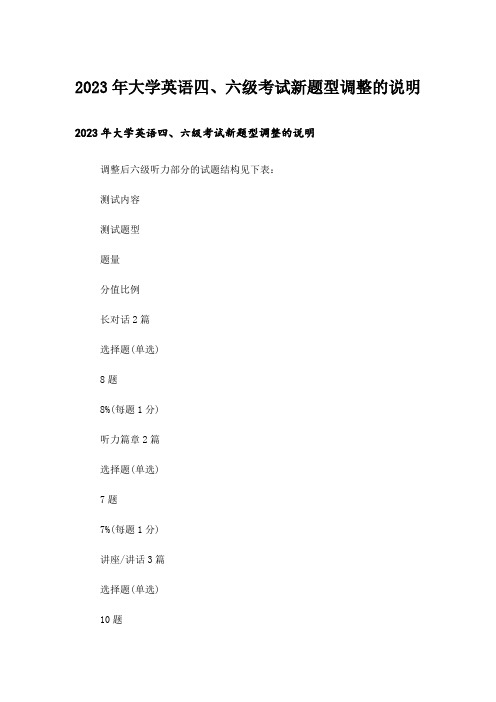
2023年大学英语四、六级考试新题型调整的说明2023年大学英语四、六级考试新题型调整的说明调整后六级听力部分的试题结构见下表:测试内容测试题型题量分值比例长对话2篇选择题(单选)8题8%(每题1分)听力篇章2篇选择题(单选)7题7%(每题1分)讲座/讲话3篇选择题(单选)10题20%(每题2分)1、六级听力之不变原来的长对话题型不变,依然是2篇。
但题目数量由7道题增至8题,依然每题1分;篇章听力题型不变,但题目数量由原来的3篇共10道题减少至2篇共7题,每题1分。
题型及难度没有变化,考生可参考旧题。
2、六级听力之变化短对话取消,听写取消。
增加讲座/讲话题型3篇共10道题,每题2分,是六级听力考试乃至全卷的关键。
下面我们就来详细解析一下新题型:Now listen to the following recording and answer questions 16 to 19.16. A) They investigate the retirement homes in America.B) They are on issues facing senior citizens in America.C) They describe the great pleasures of the golden years.D) They are filled with fond memories of his grandparents.17. A) The loss of the ability to take care of himself.B) The feeling of not being important any more.C) Being unable to find a good retirement home.D) Leaving the home he had lived in for 60 years.18. A) The loss of identity and self-worth.B) Fear of being replaced or discarded.C) Freedom from pressure and worldly cares.D) The possession of wealth and high respect.19. A) The urgency of pension reform.B) Medical care for senior citizens.C) Finding meaningful roles for the elderly in society.D) The development of public facilities for senior citizens.原文:Moderator:Hello Ladies and Gentleman, it gives me great pleasure to introduce our keynote speaker for todays session, Dr. Howard Miller. Dr. Miller, Professor of Sociology at Washington University, has written numerous articles and books on the issues facing older Americans in our graying society for the past 15 years. Dr. Miller:Dr. Miller: Thank you for that introduction. Today, Id like to preface my remarks with a story from my own life which I feel highlights the common concerns that bring us here together. Several years ago when my grandparents were well into their eighties, they were faced with the reality of no longer being able to adequately care for themselves. My grandfather spoke of his greatest fear, that of leaving the only home they had known for the past 60 years. Fighting back the tears, he spoke proudly of the fact that he had built their home from the ground up, and that he had pounded every nail and laid every brick in the process. The prospect of having to sell their home and give up their independence, and move into a retirement home was an extremely painful experience for them. It was,in my grandfathers own words, like having a limb cut off. He exclaimed in a forceful manner that he felt he wasnt important anymore.For them and some older Americans, their so-called “golden years”are at times not so pleasant, for this period can mean the decline of not only ones health but the loss of identity and self-worth. In many societies, this self-identity is closely related with our social status, occupation, material possessions, or independence. Furthermore, we often live in societies that value what is “new” or in fashion, and our own usage of words in the English language is often a sign of bad news for older Americans. I mean how would your family react if you came home tonight exclaiming, “Hey, come to the living room and see the OLD black and white TV I brought!” Unfortunately, the word “old” calls to mind images of the need to replace or discard.Now, many of the lectures given at this conference have focused on the issues of pension reform, medical care, and the development of public facilities for senior citizens. And while these are vital issues that must be addressed, Id like to focus my comments on an important issue that will affect the overall success of the other programs mentioned. This has to do with changing our perspectives on what it means to be a part of this group, and finding meaningful roles the elderly can play and should play in our societies.First of all, Id like to talk about . . .16. What does the introduction say about Dr. Howard Millers articles and books?17. What is the greatest fear of Dr. Millers grandfather?18. What does Dr. Miller say the “golden years” can often mean?19. What is the focus of Dr. Millers speech?解:这是一篇关于老龄化社会,老年人的晚年生活等问题的演讲。
大学英语四级评分标准细则

大学英语四级评分标准细则大学英语四级评分标准细则英语四级考试各部分测试内容、题型和所占分值比例如表所示:大学英语四级评分标准细则之写作:33分--条理不清、思路紊乱,语言支离破碎或大部分句子均有错误,且多数为严重错误。
39分--基本切题。
表达思想不清楚连贯性差。
有较多严重的语言错误。
45分--基本切题。
有些地方表达思想不够清楚,文字勉强连贯;语言错误相当多,其中有一些是严重错误。
57分--切题。
表达思想清楚,文字连贯,但有少量语言错误。
67分--切题。
表达思想清楚,文字通顺。
连贯性较好,基本上无语言错误,仅有个别小错。
文字不足酌情扣分:100-119扣1分;90-99扣3分;80-89扣4分;70-79扣5分;60-69扣6分;50-59扣7分;不足50扣9分。
大学英语四级评分标准细则听力:听力理解共35个,包括短对话、长对话、短文听力及短文听写:听力对话及短文听力共25题,每1题算1个,共25个;短文听写共11题,其中单词听写8题,每2题算1个,句子听写共2题,每1题算2个,共10个。
大学英语四级评分标准细则阅读:阅读理解共35个,包括快速阅读,篇章词汇或短句问答,篇章阅读:快速阅读共10题,每1题算1个,共10个;篇章词汇每2个空算1个,短句问答共5题或8题,每1题算1个或0.625个,共5个;篇章阅读共10题,每1题算2个,共20个。
大学英语四级评分标准细则综合:综合测试共15个,包括完形或改错,翻译。
完形共20题,每2题算1个,共10个;改错共10题,每1题算1个,共10个;翻译共5题,每1题算1个,共5个。
四级考试单项分的报道共分为四个部分:听力(35%)、阅读(35%)、完型填空或改错(10%)、作文和翻译(20%)。
各单项报道分的满分分别为:听力249分,阅读249分,完型填空或改错70分,作文142分。
各单项分相加之和等于总分(710分)。
大学英语四级分数换算大学英语四、六级考试的原始分数在经过加权、等值处理后,参照常模转换为均值为500、标准差为70的常模正态分数。
英语四六级考试评分标准
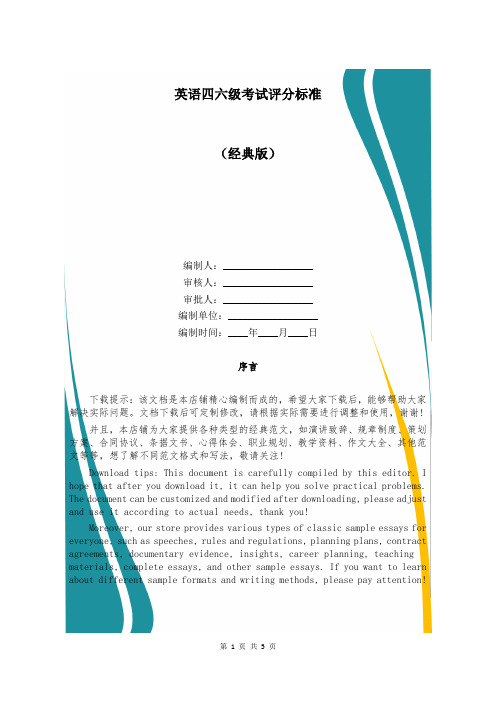
英语四六级考试评分标准(经典版)编制人:__________________审核人:__________________审批人:__________________编制单位:__________________编制时间:____年____月____日序言下载提示:该文档是本店铺精心编制而成的,希望大家下载后,能够帮助大家解决实际问题。
文档下载后可定制修改,请根据实际需要进行调整和使用,谢谢!并且,本店铺为大家提供各种类型的经典范文,如演讲致辞、规章制度、策划方案、合同协议、条据文书、心得体会、职业规划、教学资料、作文大全、其他范文等等,想了解不同范文格式和写法,敬请关注!Download tips: This document is carefully compiled by this editor. I hope that after you download it, it can help you solve practical problems. The document can be customized and modified after downloading, please adjust and use it according to actual needs, thank you!Moreover, our store provides various types of classic sample essays for everyone, such as speeches, rules and regulations, planning plans, contract agreements, documentary evidence, insights, career planning, teaching materials, complete essays, and other sample essays. If you want to learn about different sample formats and writing methods, please pay attention!英语四六级考试评分标准英语四六级考试评分标准是什么英语四六级的分数在阅卷后产生,四六级参考等级描述确定当前考试各等级的等级样卷。
英语四六级考试大纲解读全解析

英语四六级考试大纲解读全解析英语四六级考试作为全国性的英语水平考试,对于大学生的英语学习和未来发展具有重要意义。
了解考试大纲是备考的关键一步,本文将对英语四六级考试大纲进行全面解读,帮助考生更好地把握考试要求和重点。
一、考试性质与目的英语四六级考试是由教育部主管的一项全国性英语考试,其目的在于准确地测量我国在校大学生的英语综合应用能力,包括听力理解、阅读理解、写作和翻译等方面。
考试成绩不仅是对学生英语水平的评估,也在一定程度上影响着学生的毕业、就业以及升学。
二、考试内容与题型1、听力理解听力部分在四六级考试中占据较大比重。
四级听力包括短篇新闻、长对话和听力篇章;六级听力则在题型上与四级相似,但内容难度有所增加。
考生需要具备在各种场景下理解英语对话和独白的能力,能够抓住关键信息,理解主旨大意,并对细节进行准确把握。
2、阅读理解阅读理解分为词汇理解、长篇阅读和仔细阅读三种题型。
词汇理解主要考查考生对词汇的理解和运用;长篇阅读要求考生快速浏览文章,查找关键信息;仔细阅读则需要考生深入理解文章内容,分析推理,回答相关问题。
3、写作写作部分要求考生根据给定的题目或提示,在规定时间内完成一篇短文。
四级写作字数要求不少于 120 词,六级不少于 150 词。
写作主题涵盖社会热点、校园生活、个人经历等多个方面,考查考生的语言表达能力、逻辑思维能力和对各种文体的掌握程度。
4、翻译翻译部分主要考查考生的汉译英能力。
四级翻译内容多为与中国文化、历史、社会相关的简短句子或段落;六级翻译则更侧重于对复杂概念和抽象话题的翻译。
三、考试要求与能力考查1、词汇量四级要求掌握的词汇量约为 4500 个,六级则在 6000 个左右。
考生不仅要记住单词的拼写和词义,还要了解其用法和搭配。
2、语法知识掌握基本的英语语法规则,如时态、语态、从句、虚拟语气等,能够正确运用语法知识进行句子的构建和理解。
3、语言运用能力能够根据语境准确选用词汇和短语,避免中式英语表达;能够运用恰当的句型和语法结构,使句子通顺、连贯。
最新大学英语四六级考试题型调整及介绍

3)
阅读理解
• 阅读理解部分包括1篇长篇阅读和3篇仔细 阅读,测试学生在不同层面上的阅读理解 能力,包括理解篇章或段落的主旨大意和 重要细节、综合分析、推测判断以及根据 上下文推测词义等能力。该部分所占分值 比例为35%,其中长篇阅读占10%,仔细阅 读占25%。考试时间40分钟。
• 长篇阅读部分采用1篇较长篇幅的文章,总 长度四级约1000词,六级约1200词。阅读 速度四级约每分钟100词;六级约每分钟 120词。篇章后附有10个句子,每句一题。 每句所含的信息出自篇章的某一段落,要 求考生找出与每句所含信息相匹配的段落。 有的段落可能对应两题,有的段落可能不 对应任何一题。
最新大学英语四、六级考试 题型调整及介绍
• 自2013年12月考次起,全国大学英语 四、六级考试委员会将对四、六级考 试的试卷结构和测试题型作局部调整。 调整后,四级和六级的试卷结构和测 试题型相同。
一、试卷描述
• 四级和六级的试卷结构、测试内容、测试 题型、分值比例和考试时间如下表所示:
试卷结构
阅读理解 翻译 总计
40 分钟 30 分钟 130 分钟
二、新题型说明
• 1. 单词及词组听写
• 原复合式听写调整为单词及词组听写,短 文长度及难度不变。要求考生在听懂短文 的基础上,用所听到的原文填写空缺的单 词或词组,共10题。短文播放三遍。
2. 长篇阅读
• 原快速阅读理解调整为长篇阅读理解,篇 章长度和难度不变。篇章后附有10个句子, 每句一题。每句所含的信息出自篇章的某 一段落,要求考生找出与每句所含信息相 匹配的段落。有的段落可能对应两题,有 的段落可能不对应任何一题。
4-6分
1-3分 0分
条理不清,思路紊乱,语言支离破碎或大部分句子 均有错误,且多数为严重错误。
全国大学英语四六评分标准
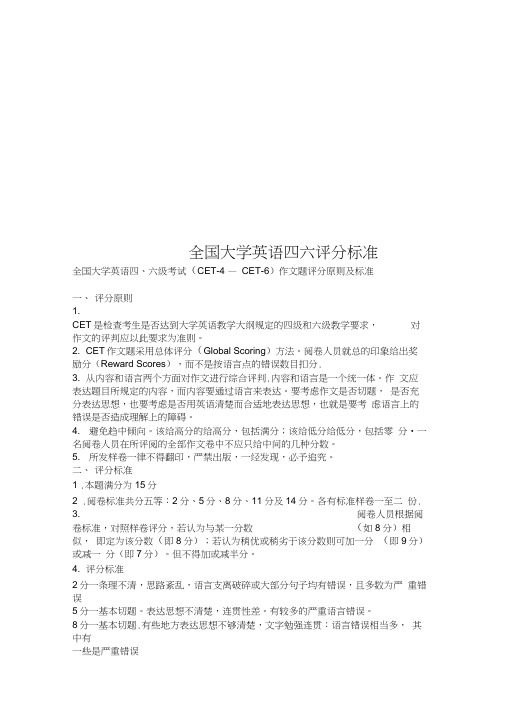
全国大学英语四六评分标准全国大学英语四、六级考试(CET-4 —CET-6)作文题评分原则及标准一、评分原则1.CET是检查考生是否达到大学英语教学大纲规定的四级和六级教学要求,对作文的评判应以此要求为准则。
2. CET作文题采用总体评分(Global Scoring)方法。
阅卷人员就总的印象给出奖励分(Reward Scores),而不是按语言点的错误数目扣分.3. 从内容和语言两个方面对作文进行综合评判.内容和语言是一个统一体。
作文应表达题目所规定的内容,而内容要通过语言来表达。
要考虑作文是否切题,是否充分表达思想,也要考虑是否用英语清楚而合适地表达思想,也就是要考虑语言上的错误是否造成理解上的障碍。
4. 避免趋中倾向。
该给高分的给高分,包括满分;该给低分给低分,包括零分•一名阅卷人员在所评阅的全部作文卷中不应只给中间的几种分数。
5. 所发样卷一律不得翻印,严禁出版,一经发现,必予追究。
二、评分标准1 .本题满分为15分2 .阅卷标准共分五等:2分、5分、8分、11分及14分。
各有标准样卷一至二份.3. 阅卷人员根据阅卷标准,对照样卷评分,若认为与某一分数(如8分)相似,即定为该分数(即8分);若认为稍优或稍劣于该分数则可加一分(即9分)或减一分(即7分)。
但不得加或减半分。
4. 评分标准2分一条理不清,思路紊乱,语言支离破碎或大部分句子均有错误,且多数为严重错误5分一基本切题。
表达思想不清楚,连贯性差。
有较多的严重语言错误。
8分一基本切题.有些地方表达思想不够清楚,文字勉强连贯:语言错误相当多,其中有一些是严重错误11分一切题。
表达思想清楚,文字连贯,但有少量语言错误。
14分一切题。
表达思想清楚,文字通顺,连贯性较好,基本上无语言错误,仅有个别小错。
[注:白卷,作文与题目毫不相关,或只有几个孤立的词而无法表达思想,则给0分。
]5. 字数不足应酌情扣分:累计字数CET-4 110~119 100~109 90~99 80~89 70~79 60~69 50~59 &t;49 CET-6 140~149 130~139 120~129 110~119 100~109 90~99 80~89 & t;79 扣分1 2 3 4 5 6 7 8 9[注:1.如题目中给出主题句,起始句,结束句,均不得计入所写字数。
2020年最新英语四六级考试题型分析(新增改革内容)

2020年最新英语四六级考试题型分析(新增改革内容)2020年最新英语四六级考试题型分析(新增改革内容)众所周知,英语四六级试卷分为四大题型:听力、阅读理解、作文和翻译。
但是你们知道四六级的分值占比和时间吗?下面小编就摆两张图片来说明咯!!!一、四六级总分值占比&考试时间四六级总分为710分,分值比例为:作文15%,听力35%,阅读35%,翻译15%,即作文106.5分,听力248.5分,阅读248.5分,翻译106.5分。
从分值可得粗,作文和翻译是很重要的,光一项就是106.5分!故二者皆不可丢!四六级考试时长130分钟,各项考试时间为:作文30分钟,听力30分钟,阅读40分钟,翻译30分钟。
二、四六级分项题型描述&分值比例说明(2020年大学英语四六级考试题型调整的说明)A、作文:写作部分测试学生用英语实行书面表达的水平。
写作测试选用考生所熟悉的题材,要求考生根据所提供的信息及提示(如:提纲、情景、图片或图表等)写出一篇短文,四级120-180词,六级150-200词。
分值占比15%。
俗话说,万事开头难,作文就是四六级的开头,想攻克作文难关嘛?赶快来向名师请教吧 >>B、听力(2020年起已改革)大学英语四、六级考试听力试题调整的说明全国大学英语四、六级考试委员会自2020年6月考试起将对四、六级考试的听力试题作局部调整。
四级听力部分各项占比:短篇新闻7%,长对话20%,听力篇章20%;六级听力部分各项占比:长对话8%,听力篇章7%,讲座/讲话20%。
听力分值占比15%。
1)四级对话部分(Listening Conversations):对话部分共25题,包括短篇新闻,长对话和听力篇章。
均采用多项选择题的形式实行考核,每段对话均朗读一遍。
短篇新闻:有3段,共7题,每题1分;分值占比7%。
长对话:有2篇,共8题,每题1分;分值占比8%。
听力篇章:有3篇,共10题,每题2分;分值占比20%。
大学英语四六级各部分分值精选全文

可编辑修改精选全文完整版
四级各部分测试内容、题型、所占比例及满分分值
考试由四部分构成:听力理解、阅读理解、综合测试和写作测试。
各部分测试内容、题型和所占比例如下表所示:
四级考试单项分的报道共分为四个部分:听力(35%)、阅读(35%)、完型填空或改错(10%)、作文和翻译(20%)。
各单项报道分的满分分别为:听力249分,阅读249分,完型填空或改错70分,作文142分。
各单项分相加之和等于总分(710分)。
710分四级考试具体考试流程如下:
8:50---9:00试音寻台时间
9:00---9:10播放考场指令,发放作文考卷
9:10取下耳机,开始作文考试
9:35发放含有快速阅读的试题册(但9:40才允许开始做) 9:40---9:55做快速阅读
9:55---10:00收答题卡一(即作文和快速阅读)
9:55---10:00重新戴上耳机,试音寻台,准备听力考试10:00开始听力考试,电台开始放音
听力结束后完成剩余考项
11:20全部考试结束。
6月英语四六级考试改革调整的说明含样题
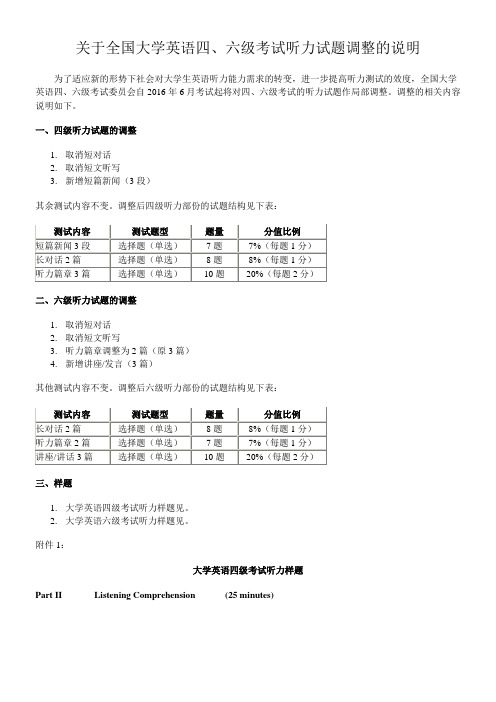
关于全国大学英语四、六级考试听力试题调整的说明为了适应新的形势下社会对大学生英语听力能力需求的转变,进一步提高听力测试的效度,全国大学英语四、六级考试委员会自2016年6月考试起将对四、六级考试的听力试题作局部调整。
调整的相关内容说明如下。
一、四级听力试题的调整1.取消短对话2.取消短文听写3.新增短篇新闻(3段)其余测试内容不变。
调整后四级听力部份的试题结构见下表:二、六级听力试题的调整1.取消短对话2.取消短文听写3.听力篇章调整为2篇(原3篇)4.新增讲座/发言(3篇)其他测试内容不变。
调整后六级听力部份的试题结构见下表:三、样题1.大学英语四级考试听力样题见。
2.大学英语六级考试听力样题见。
附件1:大学英语四级考试听力样题Part II Listening Comprehension (25 minutes)Section ADirections: In this section, you will hear three news reports. At the end of each news report, you will hear two or three questions. Both the news report and the questions will be spoken only once. After you hear a question, you must choose the best answer from the four choices marked A), B), C) and D). Then mark the corresponding letter on Answer Sheet 1 with a single line through the centre.Questions 1 and 2 will be based on the following news item.1. A) Christmas-time attacks made by Somali rebels.B) An explosion at a bus station in central Nairobi.C) The killing of more than 70 Ugandans in Kampala.D) Blasts set off by a Somali group in Uganda’s capital.2. A) On Christmas Eve. C) During a security check.B) Just before midnight. D) In the small hours of the morning.Questions 3 and 4 will be based on the following news item.3. A) It is likely to close many of its stores.B) It is known for the quality of its goods.C) It remains competitive in the recession.D) It will expand its online retail business.4. A) Expand its business beyond groceries.B) Fire 25,000 of its current employees.C) Cut its DVD publishing business.D) Sell the business for one pound.Questions 5 to 7 will be based on the following news item.5. A) All taxis began to use meters.B) All taxis got air conditioning.C) Advertisements were allowed on taxis.D) Old taxis were replaced with new cabs.6. A) A low interest loan scheme. C) Taxi passengers’ complaints.B) Environmentalists’ protests. D) Permission for car advertising.7. A) There are no more irregular practices.B) All new cabs provide air-conditioning.C) New cabs are all equipped with meters.D) New legislation protects consumer rights.Section BDirections: In this section, you will hear two long conversations. At the end of each conversation, you will hear four questions. Both the conversation and the questions will be spoken only once. After you hear a question, you must choose the best answer from the four choices marked A), B), C) and D). Then mark the corresponding letter on Answer Sheet1 with a single line through the centre.Conversation OneQuestions 8 to 11 are based on the conversation you have just heard.8. A) It has a partnership with LCP. C) It specializes in safety from leaks.B) It is headquartered in London. D) It has a chemical processing plant.9. A) He is a chemist. C) He is a safety inspector.B) He is a salesman. D) He is Mr. Grand’s friend.10. A) The public relations officer. C) Director of the safety department.B) Mr. Grand’s personal assistant. D) Head of the personnel department.11. A) Wait for Mr. Grand to call back.B) Leave a message for Mr. Grand.C) Provide details of their products and services.D) Send a comprehensive description of their work.Conversation TwoQuestions 12 to 15 are based on the conversation you have just heard.12. A) Teacher. C) Editor.B) Journalist. D) Typist.13. A) Some newly discovered scenic spot.B) Big changes in the Amazon valley.C) A new railway under construction.D) The beautiful Amazon rainforests.14. A) In news weeklies. C) In newspapers’ Sunday editions.B) In a local evening paper. D) In overseas editions of U.S. magazines.15. A) To become a professional writer. C) To get her life story published soon.B) To be employed by a newspaper. D) To sell her articles to a news service.Section CDirections: In this section, you will hear three passages. At the end of each passage, you will hear some questions. Both the passage and the questions will be spoken only once. After you hear a question, you must choose the best answer from the four choices marked A), B), C) and D). Then mark the corresponding letter on Answer Sheet 1 with a single line through the centre.Passage OneQuestions 16 to 18 are based on the passage you have just heard.16. A) She is both a popular and a highly respected author.B) She is the first writer to focus on the fate of slaves.C) She is the most loved African novelist of all times.D) She is the most influential author since the 1930’s.17. A) The Book Critics Circle Award. C) The Pulitzer Prize for fiction.B) The Nobel Prize for literature. D) The National Book Award.18. A) She is a relative of Morrison’s. C) She is a skilled storyteller.B) She is a slave from Africa. D) She is a black woman.Passage TwoQuestions 19 to 21 are based on the passage you have just heard.19. A) They are very generous in giving gifts.B) They refuse gifts when doing business.C) They regard gifts as a token of friendship.D) They give gifts only on special occasions.20. A) They enjoy giving gifts to other people.B) They spend a lot of time choosing gifts.C) They have to follow many specific rules.D) They pay attention to the quality of gifts.21. A) Gift-giving plays an important role in human relationships.B) We must be aware of cultural differences in giving gifts.C) We must learn how to give gifts before going abroad.D) Reading extensively can make one a better gift-giver. Passage ThreeQuestions 22 to 25 are based on the passage you have just heard.22. A) She tenderly looked after her sick mother.B) She developed a strong interest in finance.C) She learned to write for financial newspapers.D) She invested in stocks and shares on Wall Street.23. A) She inherited a big fortune from her father.B) She sold her restaurant with a substantial profit.C) She got 7.5 million dollars from her ex-husband.D) She made a wise investment in real estate.24. A) She was dishonest in business dealings.B) She frequently ill-treated her employees.C) She abused animals including her pet dog.D) She was extremely mean with her money.25. A) She carried on her family’s tradition.B) She made huge donations to charities.C) She built a hospital with her mother’s money.D) She made a big fortune from wise investments.Tape Script of Listening ComprehensionSection ADirections: In this section, you will hear three news reports. At the end of each news report, you will hear two or three questions. Both the news report and the questions will be spoken only once. After you hear a question, you must choose the best answer from the four choices marked A), B), C) and D). Then mark the corresponding letter on Answer Sheet 1 with a single line through the centre.Questions 1 and 2 will be based on the following news item.Kenyan police say one person was killed and 26 injured in an explosion at a bus station in central Nairobi. The blast hit a bus about to set off for the Ugandan capital Kampala. LastJuly, the Somali group al-Shabab said it was behind the blasts in the Ugandan capital which killed more than 70 people. Will Ross reports from the Kenyan capital.The explosion happened beside a bus which was about to set off for an overnight journey from Nairobi to the Ugandan capital Kampala. Some eyewitnesses report that a bag was about to be loaded on board, but it exploded during a security check. Windows of the red bus were left smashed, and blood could be seen on the ground beside the vehicle. Just hours earlier, Uganda’s police chief had warn ed of possible Christmas-time attacks by Somali rebels.1. What is the news report mainly about?2. When did the incident occur?Questions 3 and 4 will be based on the following news item.Woolworths is one of the best known names on the British High Street. It’s been in business nearly a century. Many of its 800 stores are likely to close following the company’s decision to call in administrators after an attempt to sell the business for a token £1 failed.The company has huge debt s. The immediate cause for the collapse has been Britain’s slide toward recession, which has cut into consumer spending. However, the business had been in trouble for years.Known for low-priced general goods, Woolworths has struggled in the face of competition from supermarkets expanding beyond groceries and a new generation of internet retailers.Many of the store group’s 25,000 employees are likely to lose their jobs. Some profitable areas such as the DVD publishing business will survive.3. What do we learn about Woolworths from the news report?4. What did Woolworths attempt to do recently?Questions 5 to 7 will be based on the following news item.Cairo is known for its overcrowded roads, irregular driving practices and shaky old vehicles, but also for its air pollution. In recent months, though, environmental studies indicate there have been signs of improvement. That’s due in part to the removal of many of the capital’s old-fashioned black and white taxis. Most of these dated back to the 1960s and 70s and were in a poor state of repair.After new legislation demanded their removal from the roads, a low interest loan scheme was set up with three Egyptian banks so drivers could buy new cars. The government pays about $900 for old ones to be discarded and advertising on the new vehicles helps cover repayments.The idea has proved popular with customers ― they can now travel in air-conditioned comfort and because the new cabs are metered, they don’t have to argue over fares. Banks and car manufacturers are glad for the extra business in tough economic times. As for the taxi drivers, most are delighted to be behind the wheel of new cars, although there have been a few complaints about switching from black and white to a plain white colour.5. What change took place in Cairo recently?6. What helped bring about the change?7. Why do customers no longer argue with new cab drivers?Section BDirections: In this section, you will hear two long conversations. At the end of each conversation, you will hear four questions. Both the conversation and the questions will be spoken only once. After you hear a question, you must choosethe best answer from the four choices marked A), B), C) and D). Then mark the corresponding letter on Answer Sheet 1 with a single line through the centre.Conversation OneW: Morning, this is TGC.M: Good morning. Walter Barry here, calling from London. Could I speak to Mr. Grand, please?W: Who’s calling, please?M: Walter Barry, from London.W: What is it about, please?M: Well, I understand that your company has a chemical processing plant. My own company, LCP, Liquid Control Products, is a leader in safety from leaks in the field of chemical processing. I would like to speak to Mr. Grand to discuss ways in which we could help TGC protect itself from such problems and save money at the same time.W: Yes, I see. Well, Mr. Grand is not available just now.M: Can you tell me when I could reach him?W: He’s very busy for the next few days –then he’ll be away in New York. So it’s difficult to give you a time.M: Could I speak to someone else, perhaps?W: Who in particular?M: A colleague for example?W: You’re speaking to his personal assistant. I can deal with calls for Mr. Grand.M: Yes, well, could I ring him tomorrow?W: No, I’m sorry he won’t be free tomorrow. Listen, let me suggest something. You send us details of your products and services, together with references from other companies and then we’ll contact you.M: Yes, that’s very kind of you. I have y our address.W: Very good, Mr….M: Barry. Walter Barry from LCP in London.W: Right, Mr. Barry. We look forward to hearing from you.M: Thank you. Goodbye.W: Bye.Questions 8 to 11 are based on the conversation you have just heard.8. What do we learn a bout the woman’s company?9. What do we learn about the man?10. What is the woman’s position in her company?11. What does the woman suggest the man do?Conversation TwoM: You’re going to wear out the computer’s keyboard!W: Oh, hi.M: Do you have any idea what time it is?W: About ten or ten-thirty?M: It’s nearly midnight.W: Really? I didn’t know it was so late.M: Don’t you have an early class to teach tomorrow morning?W: Yes, at seven o’clock. My commuter class, the students who go to work right after their lesson.M: Then you ought to go to bed. What are you writing, anyway?W: An article I hope I can sell.M: Oh, another of your newspaper pieces? What’s this one about?W: Do you remember the trip I took last month?M: The one up to the Amazon?W: Well, that’s what I’m writing about—the new highway and the changes it’s making in the Amazon valley.M: It should be interesting.W: It is. I guess that’s why I forgot all about the time.M: How many articles have you sold now?W: About a dozen so far.M: What kind of newspapers buy them?W: The papers that carry a lot of foreign news. They usually appear in the big Sunday editions where they need a lot of background stories to help fill up the space between the ads.M: Is there any future in it?W: I hope so. There’s a chance I may sell this article to a news service.M: Then your story would be published in several papers, wouldn’t it?W: That’s the idea. And I might even be able to do other stories on a regular basis.M: That would be great.Questions 12 to 15 are based on the conversation you have just heard.12. What is the woman’s occupation?13. What is the woman writing about?14. Where do the woman’s articles usually appear?15. What does the woman expect?Section CDirections: In this section, you will hear three passages. At the end of each passage, you will hear some questions. Both the passage and the questions will be spoken only once. After you hear a question, you must choose the best answer from the four choices marked A), B), C) and D). Then mark the corresponding letter on Answer Sheet 1 with a single line through the centre.Passage OneIn today’s class, we’ll discuss Toni Morrison’s novel Beloved.As I’m sure you all know, Morrison is both a popular and a highly respected author, and it’s not easy to be both. Born in 1931, Morrison has written some of the most touching and intelligent works on theAfrican-American experience ever written by anyone, and yet to call her an“African-American writer” doesn’t seem to do her justice. In many ways, she’s simply an American writer—and certainly one of our best.Beloved is a truly remarkable work. It was recommended for nearly every major literary prize, including the National Book Award and the National Book Critics Circle Award, and it in fact won the Pulitzer Prize for fiction in 1988. Morrison herself is distinguished for having won the Nobel Prize for literature in 1993.What makes Beloved unique is the skillful, sure way in which Morrison blends intensely personal storytelling and American history, racial themes and gender themes, the experience of Blacks with the experience of all people everywhere, the down-to-earth reality of slavery with a sense of mysterious spirituality.W e’ll be paying special attention to these themes as we discuss this work. I’m particularly interested in your views on the relative importance of race and gender in this book. Is it more important that Sethe, the main character, is black or that she’s a wo man? Which contributes more to her being? What does Morrison tell us about both?Questions 16 to 18 are based on the passage you have just heard.16. What do we learn about Toni Morrison?17. What honor did Toni Morrison receive in 1993?18. What does the speaker tell us about Sethe, the main character in Morrison’snovel Beloved?Passage TwoThe topic of my talk today is gift-giving. Everybody likes to receive gifts, right? So you may think that gift-giving is a universal custom. But actually, the rules of gift-giving vary quite a lot, and not knowing them can result in great embarrassment. In North America, the rules are fairly simple. If you’re invited to someone’s home for dinner, bring wine or flowers or a small item from your co untry. Among friends, family, and business associates, we generally don’t give gifts on other occasions except on someone’s birthday and Christmas. The Japanese, on the other hand, give gifts quite frequently, often to thank someone for their kindness. The tradition of gift-giving in Japan is very ancient. There are many detailed rules for everything from the color of the wrapping paper to the time of the gift presentation. And while Europeans don’t generally exchange business gifts, they do follow some for mal customswhen visiting homes, such as bringing flowers. The type and color of flowers, however, can carry special meaning.Today we have seen some broad differences in gift-giving. I could go on with additional examples. But let’s not miss the main poi nt here: If we are not aware of and sensitive to cultural differences, the possibilities for miscommunication and conflict are enormous. Whether we learn about these differences by reading a book or by living abroad, our goal must be to respect differences among people in order to get along successfully with our global neighbors.Questions 19 to 21 are based on the passage you have just heard.19. What does the speaker say about gift-giving of North Americans?20. What do we learn about the Japanese concerning gift-giving?21. What point does the speaker make at the end of the talk?Passage ThreeHetty Green was a very spoilt, only child. She was born in Massachusetts, USA, in 1835. Her father was a millionaire businessman. Her mother was often ill, and so from the age of two her father took her with him to work and taught her about stocks and shares. At the age of six she started reading the daily financial newspapers and opened her own bank account.Her father died when she was 21 and she inherited $7.5 million. She went to New York and invested on Wall Street. Hetty saved every penny, eating in the cheapest restaurants for 15 cents. She became one of the richest and most hated women in the world. At 33 she married Edward Green, a multi-millionaire, and had two children, Ned and Sylvia.Hetty’s meanness was well known. She always argued about prices in shops. She walked to the local grocery store to buy broken biscuits which were much cheaper, and to get a free bone for her much loved dog. Once she lost a two-cent stamp and spent the night looking for it. She never bought clothes and always wore the same long, ragged black skirt. Worst of all, when her son Ned fell and injured his knee, she refused to pay for a doctor and spent hours looking for free medical help. In the end Ned lost his leg.When she died in 1916 she left her children $100 million. Her daughter built a hospital with her money.Questions 22 to 25 are based on the passage you have just heard.22. What do we learn about Hetty Green as a child?23. How did Hetty Green become rich overnight?24. Why was Hetty Green much hated?25. What do we learn about Hetty’s daughter?参考答案Part II Listening Comprehension Section A1. B2. C3. A4. D5. D6. A7. CSection B8. D9. B10. B11. C12. A13. B14. C15. DSection C16. A17. B18. D19. D20. C21. B22. B23. A24. D25. C附件2:大学英语六级考试听力样题Part II Listening Comprehension (30 minutes)Section ADirections: In this section, you will hear two long conversations. At the end of each conversation, you will hear some questions. Both the conversation andthe questions will be spoken only once. After you hear a question, you must choose the best answer from the four choices marked A), B), C) and D). Then mark the corresponding letter on Answer Sheet 1with a single line through the centre.Conversation OneQuestions 1 to 4 are based on the conversation you have just heard.1. A) He invented the refrigerator. C) He was admitted to a university.B) He patented his first invention. D) He got a degree in Mathematics.2. A) He started to work on refrigeration.B) He became a professor of Mathematics.C) He fell in love with Natasha Willoughby.D) He distinguished himself in low temperature physics.3. A) Discovering the true nature of subatomic particles.B) Their explanation of the laws of cause and effect.C) Their work on very high frequency radio waves.D) Laying the foundations of modern mathematics.4. A) To have a three-week holiday. C) To patent his inventions.B) To spend his remaining years. D) To teach at a university.Conversation TwoQuestions 5 to 8 are based on the conversation you have just heard.5. A) The injury of some students.B) A school bus crash on the way.C) The collapse of a school building.D) A fire that broke out on a school campus.6. A) Teaching. C) Having lunch.B) On vacation. D) Holding a meeting.7. A) A malfunctioning stove. C) Violation of traffic rules.B) Cigarettes butts left by workers. D) Negligence in school maintenance.8. A) Sent a story to the local newspaper.B) Threw a small Thanksgiving party.C) Baked some cookies as a present.D) Wrote a personal letter of thanks.Section BDirections:In this section, you will hear two passages. At the end of each passage, you will hear some questions. Both the passage and the questions willbe spoken only once. After you hear a question, you must choose the best answer from the four choices marked A), B), C) and D). Then mark the corresponding letter on Answer Sheet 1 with a single line through the centre.Passage OneQuestions 9 to 11 are based on the passage you have just heard.9. A) It is a trait of a generous character. C) It is an indicator of high intelligence.B) It is a reflection of self-esteem. D) It is a sign of happiness and confidence.10. A) It was self-defeating. C) It was the essence of comedy.B) It was aggressive. D) It was something admirable.11. A) It is a double-edged sword. C) It is a unique gift of human beings.B) It is a feature of a given culture. D) It is a result of both nature and nurture.Passage TwoQuestions 12 to 15 are based on the passage you have just heard.12. A) She is a tourist guide. C) She is a domestic servant.B) She is an interpreter. D) She is from the royal family.13. A) It is situated at the foot of a beautiful mountain.B) It was used by the family to hold dinner parties.C) It was frequently visited by heads of state.D) It is furnished like one in a royal palace.14. A) It is elaborately decorated. C) It is very big, with only six slim legs.B) It has survived some 2,000 years. D) It is shaped like an ancient Spanish boat.15. A) They are interesting to look at.B) They have lost some of their legs.C) They do not match the oval table at all.D) They are uncomfortable to sit in for long.Section CDirections: In this section, you will hear recordings of lectures or talksfollowed by some questions. The recordings will be played only once. After you hear a question, you must choose the best answer from the four choices marked A), B), C) and D). Then mark the corresponding letter on Answer Sheet 1 with a single line through the centre.Now listen to the following recording and answer questions 16 to 19.16. A) They investigate the retirement homes in America.B) They are on issues facing senior citizens in America.C) They describe the great pleasures of the golden years.D) They are filled with fond memories of his grandparents.17. A) The loss of the ability to take care of himself.B) The feeling of not being important any more.C) Being unable to find a good retirement home.D) Leaving the home he had lived in for 60 years.18. A) The loss of identity and self-worth.B) Fear of being replaced or discarded.C) Freedom from pressure and worldly cares.D) The possession of wealth and high respect.19. A) The urgency of pension reform.B) Medical care for senior citizens.C) Finding meaningful roles for the elderly in society.D) The development of public facilities for senior citizens.Now listen to the following recording and answer questions 20 to 22.20. A) It seriously impacts their physical and mental development.B) It has become a problem affecting global economic growth.C) It is a common problem found in underdeveloped countries.D) It is an issue often overlooked by parents in many countries.21. A) They will live longer. C) They get along well with people.B) They get better pay. D) They develop much higher IQs.22. A) Appropriated funds to promote research of nutrient-rich foods.B) Encouraged breastfeeding for the first six months of a child’s lif e.C) Recruited volunteers to teach rural people about health and nutrition.D) Targeted hunger-relief programs at pregnant women and young children. Now listen to the following recording and answer questions 23 to 25.23. A) The guaranteed quality of its goods.B) The huge volume of its annual sales.C) The service it provides to its customers.D) The high value-to-weight ratio of its goods.24. A) Those having a taste or smell component.B) Products potentially embarrassing to buy.C) Those that require very careful handling.D) Services involving a personal element.25. A) Those who live in the virtual world.B) Those who have to work long hours.C) Those who are used to online transactions.D) Those who don’t mind paying a lit tle more.Tape Script of Listening ComprehensionSection ADirections: In this section, you will hear two long conversations. At the end of each conversation, you will hear some questions. Both the conversation and the questions will be spoken only once. After you hear a question, you must choose the best answer from the four choices marked A), B), C) and D). Then mark the corresponding letter on Answer Sheet 1with a single line through the centre.Conversation OneW: Hello.M: Hello, is that the reference library?W: Yes. Can I help you?M: I hope so. I rang earlier and asked for some information about Denys Hawtin, the scientist. You asked me to ring back.W: Oh, yes. I have found something.M: Good. I’ve got a pencil and paper. Pe rhaps you could read out what it says.W: Certainly. Hawtin, Denys. Born: Darlington 1836; died New York 1920.M: Yes. Got that.W: Inventor and physicist. The son of a farm worker, he was admitted to the University of London at the age of fifteen.M: Yes.W: He graduated at seventeen with a first class degree in Physics and Mathematics. All right?M: Yes, all right.W: He made his first notable achievement at the age of eighteen. It was a method of refrigeration which arose from his work in low temperature physics. He became professor of Mathematics at the University of Manchester at twenty-four, where he remained for twelve years. During that time he married one of his students,Natasha Willoughby.M: Yes. Go on.W: Later, working together in London, they laid the foundation of modern Physics by showing that normal laws of cause and effect do not apply at the level of subatomic particles. For this he and his wife received the Nobel Prize for Physics in 1910, and did so again in 1912 for their work on very high frequency radio waves. In his lifetime Hawtin patented 244 inventions. Do you want any more?M: Yes. When did he go to America?W: Let me see. In 1920 he went to teach in New York, and died there suddenly after only three weeks. Still, he was a good age.M: Yes. I suppose so. Well, thanks.Questions 1 to 4 are based on the conversation you have just heard.1. What do we learn about Denys Hawtin when he was 15?2. What did Denys Hawtin do at the age of 24?3. For what were Denys Hawtin and his wife awarded the Nobel Prize a second time?4. Why did Denys Hawtin go to New York?Conversation TwoW: This is Lisa Meyer in the WBZ newsroom, talking with Mike Bassichis, who is the director of the Gifford School, about the cleanup fr om last week’s fire and what the possible cause of that blaze may have been.M: We’re getting ready for our entire staff to return early from vacation tomorrow whereupon we are going to move into temporary classrooms. And the other buildings that did not burn are being de-smoked. As to the cause of the fire, all we know is that we were having trouble with the pilot lights since we bought the stove in July and it had been serviced three times. Well, as a matter of fact, we think it was a malfunctioning stove that may have caused the fire. Nothing definite yet has been determined.W: Have you heard from other schools or other institutional users of this stove that have had the same problem?M: No. I wouldn’t know anything more about the stove itself. All I kno w is that this fire went up so quickly that there’s been a suspicion about why it went up so quickly. And it may be that there was a gas blast. But, again, this has not been determined officially by anybody.。
12月起英语四、六级考试题型将有4大调整

12月起英语四、六级考试题型将有4大调整
2013年12月起英语四、六级考试题型将有4大调整
自2013年12月起,全国大学英语四、六级考试委员会将对四、六级考试的试卷结构和测试题型作局部调整。
调整后,四级和六级的试卷结构和测试题型相同,原本的完形填空题被取消,新增短句翻译,考试时间由120分钟延长至130分钟。
全国大学英语四、六级考试改革一直是社会关注热点。
此次四、六级考试调整包括4个方面:听力部分的复合式听写部分由过去的8个单词和3句话的题目形式,改成了考察10个单词或短语的形式。
快速阅读部分变成段落信息匹配题,其中四级考试需要看10个左右的段落,然后匹配10个信息点;六级则是15个段落,匹配10个信息点。
完形填空消失,取而代之的是经过加长版本的'短句翻译,即将一篇完整的小文章,中文翻成英文。
考试时间从过去的120分钟延长到了130分钟。
考试调整以后,考生如何备考?新东方一名英语老师认为,对于听力部分来说,考生首先单词要背得熟悉,不但要搞清楚它的发音,更要弄清具体用法。
平时要注意积累单词拼写知识,在最后答题时才会比较顺手。
阅读题型的变革,对于学生的要求比较高,尤其是四、六级考生学生,要注意提高阅读能力,比如读文章的时候要养成用英语直接阅读的习惯,这样才能保证阅读速度又快又准。
短句翻译关键要了解语法,然后可以根据拆分和组合的法则进行翻译。
另悉,新的大学四、六级考试办法将从今年12月21日执行。
【2013年12月起英语四、六级考试题型将有4大调整】。
全国大学英语四六评分标准(精选五篇)
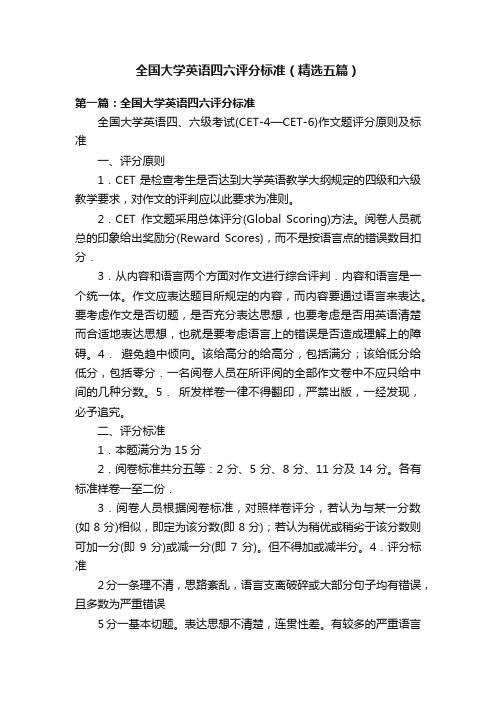
全国大学英语四六评分标准(精选五篇)第一篇:全国大学英语四六评分标准全国大学英语四、六级考试(CET-4—CET-6)作文题评分原则及标准一、评分原则1.CET是检查考生是否达到大学英语教学大纲规定的四级和六级教学要求,对作文的评判应以此要求为准则。
2.CET作文题采用总体评分(Global Scoring)方法。
阅卷人员就总的印象给出奖励分(Reward Scores),而不是按语言点的错误数目扣分.3.从内容和语言两个方面对作文进行综合评判.内容和语言是一个统一体。
作文应表达题目所规定的内容,而内容要通过语言来表达。
要考虑作文是否切题,是否充分表达思想,也要考虑是否用英语清楚而合适地表达思想,也就是要考虑语言上的错误是否造成理解上的障碍。
4.避免趋中倾向。
该给高分的给高分,包括满分;该给低分给低分,包括零分.一名阅卷人员在所评阅的全部作文卷中不应只给中间的几种分数。
5.所发样卷一律不得翻印,严禁出版,一经发现,必予追究。
二、评分标准1.本题满分为15分2.阅卷标准共分五等:2分、5分、8分、11分及14分。
各有标准样卷一至二份.3.阅卷人员根据阅卷标准,对照样卷评分,若认为与某一分数(如8分)相似,即定为该分数(即8分);若认为稍优或稍劣于该分数则可加一分(即9分)或减一分(即7分)。
但不得加或减半分。
4.评分标准2分一条理不清,思路紊乱,语言支离破碎或大部分句子均有错误,且多数为严重错误5分一基本切题。
表达思想不清楚,连贯性差。
有较多的严重语言错误。
8分一基本切题.有些地方表达思想不够清楚,文字勉强连贯:语言错误相当多,其中有一些是严重错误11分一切题。
表达思想清楚,文字连贯,但有少量语言错误。
14分一切题。
表达思想清楚, 文字通顺, 连贯性较好,基本上无语言错误,仅有个别小错。
[注:白卷,作文与题目毫不相关,或只有几个孤立的词而无法表达思想,则给0分。
] 5.字数不足应酌情扣分:累计字数CET-4 110~119 100~109 90~99 80~89 70~79 60~69 50~59 <49 CET-6 140~149 130~139 120~129 110~119 100~109 90~99 80~89 <79 扣分 1 2 3 4 5 6 7 8 9 [注:1.如题目中给出主题句,起始句,结束句,均不得计入所写字数。
最新大学英语四六级考试题型及分数比重

关于大学英语四、六级考试相关材料及说明121.试卷构成3四级和六级的试卷构成相同,由写作、听力理解、阅读理解和翻译四个4部分组成,分值比例为:写作15%,听力35%,阅读35%,翻译15%。
考试时间5为130分钟。
四级和六级的试卷结构、测试内容、测试题型、分值比例和考试6时间如下表所示:72、题型描述81)写作9写作部分测试学生用英语进行书面表达的能力,所占分值比例为15%,考10试时间30分钟。
写作测试选用考生所熟悉的题材,要求考生根据所提供的信息11及提示(如:提纲、情景、图片或图表等)写出一篇短文,四级120-180词,六12级150-200词。
132) 听力理解14听力理解部分测试学生获取口头信息的能力。
录音材料用标准的英式或15美式英语朗读,语速四级约每分钟130词,六级约每分钟150词。
听力部分分16值比例为35%,其中对话占15%,短文占20%。
考试时间30分钟。
17对话部分包括短对话和长对话,采用多项选择题的形式进行考核。
短对话18有8段,每段提一个问题;长对话有2段,每段提3-4个问题;对话部分共15题。
19每段对话均朗读一遍,每个问题后留有13-15秒的答题时间。
20短文部分包括短文理解及单词和词组听写。
短文理解有3篇,采用多项选择题的形式进行考核。
四级每篇长度为220-250词,六级为240-270词。
每篇2122短文朗读一遍,提3-4个问题,每个问题后留有13-15秒的答题时间,共10题。
23单词及词组听写采用1篇短文,四级的长度为220-250词,六级为240-270词。
要求考生在听懂短文的基础上用所听到的原文填写空缺的单词或词组,共10题。
2425短文播放三遍。
263)阅读理解27阅读理解部分包括1篇长篇阅读和3篇仔细阅读,测试学生在不同层面上28的阅读理解能力,包括理解篇章或段落的主旨大意和重要细节、综合分析、推29测判断以及根据上下文推测词义等能力。
该部分所占分值比例为35%,其中长篇30阅读占10%,仔细阅读占25%。
大学英语四六级算分标准及评分细则-细则-精选全文完整版

可编辑修改精选全文完整版大学英语四六级算分标准及评分细则英语四六级考试是教育部主管的一项全国性的英语考试,其目的是对大学生的实际英语能力进行客观、准确的测量,为大学英语教学提供测评服务。
那么大家知道四六级的分数是怎么换算出来的吗?小编这就收集整理了部分消息,仅供参考!大学英语四六级算分标准及评分细则大学英语四、六级考试的原始分数在经过加权、等值处理后,参照常模转换为均值为500、标准差为70的常模正态分数。
同时,四、六级考试不设及格线,考试合格证书改为成绩报告单。
四、六级考试单项分的报道分为四个部分,这四个部分以及各部分所占的分值比例分别为:听力(20%)、阅读(40%)、综合(25%)、(15%)。
各单项报道分的满分分别为:听力142分;阅读284分;综合178分;作文106分。
各单项报道分相加之和等于报道总分。
四、六级的单项报道分也是常模正态分数,但参照的常模是相应的单项常模。
因此,单项报道分能够报道考生在各单项常模群体中所处的百分位置。
举例如下:某考生四级作文报道分数是62分,则其在常模群体中的百分位是在77%~86%之间,表示这名考生的英语成绩至少要优于常模群体中77%的人,但不会优于86%的人。
某考生六级听力报道分数是100分,则其在常模群体中的百分位是54%,表示这名考生的英语听力成绩优于常模群体中54%的人。
大学英语四级考试得分换算表一、写作的评分标准说明:写作部分占整套试卷的15%二、听力部分的评分换算法说明:1)听力部分占整套试题的35%,最高分71分,最低分29分。
2)其中短对话~短文听力,每题算一题,共计25个题;听写单词句子共11个题,每两个单词算一个题,每个句子算2个题,共计10个。
三、阅读部分的评分换算法说明:1)阅读部分占整套试题的35%,最高分71分,最低分29分。
2)其中快速阅读,每题算一题,共10个;15选10,每两个空算一个题,共5个;篇章精读,每题算两个题,共20个。
2013年12月大学英语四级六级考试题型调整说明
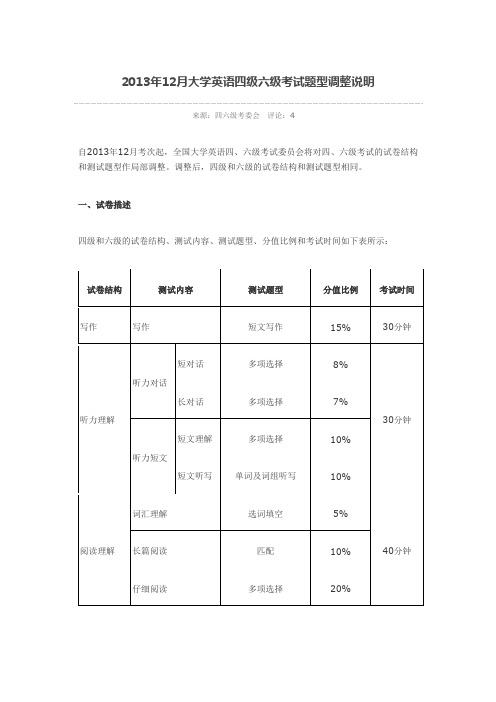
2013年12月大学英语四级六级考试题型调整说明来源:四六级考委会评论:4自2013年12月考次起,全国大学英语四、六级考试委员会将对四、六级考试的试卷结构和测试题型作局部调整。
调整后,四级和六级的试卷结构和测试题型相同。
一、试卷描述四级和六级的试卷结构、测试内容、测试题型、分值比例和考试时间如下表所示:试卷结构测试内容测试题型分值比例考试时间写作写作短文写作15% 30分钟听力理解听力对话短对话多项选择8%30分钟长对话多项选择7%听力短文短文理解多项选择10%短文听写单词及词组听写10%阅读理解词汇理解选词填空5%40分钟长篇阅读匹配10%仔细阅读多项选择20%翻译汉译英段落翻译15% 30分钟总计100% 130分钟二、新题型说明1. 单词及词组听写原复合式听写调整为单词及词组听写,短文长度及难度不变。
要求考生在听懂短文的基础上,用所听到的原文填写空缺的单词或词组,共10题。
短文播放三遍。
2. 长篇阅读原快速阅读理解调整为长篇阅读理解,篇章长度和难度不变。
篇章后附有10个句子,每句一题。
每句所含的信息出自篇章的某一段落,要求考生找出与每句所含信息相匹配的段落。
有的段落可能对应两题,有的段落可能不对应任何一题。
3. 翻译原单句汉译英调整为段落汉译英。
翻译内容涉及中国的历史、文化、经济、社会发展等。
四级长度为140-160个汉字;六级长度为180-200个汉字。
三、成绩报道成绩报道分为总分和单项分。
单项分包括:1)听力,2)阅读,3)翻译和写作。
全国大学英语四六评分标准
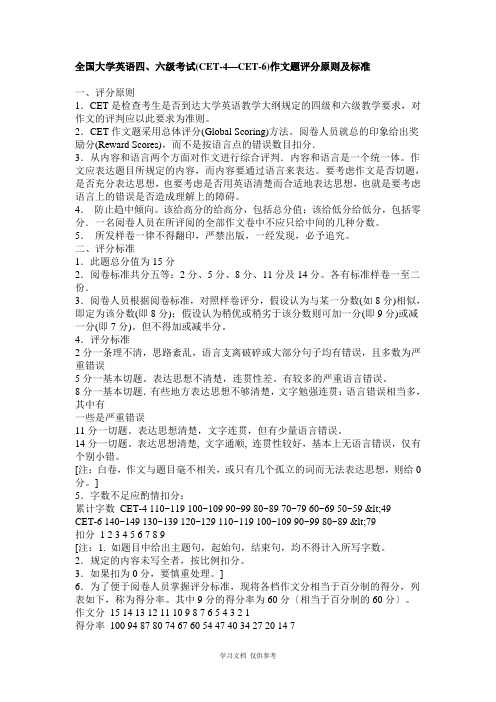
全国大学英语四、六级考试(CET-4—CET-6)作文题评分原则及标准一、评分原则1.CET是检查考生是否到达大学英语教学大纲规定的四级和六级教学要求,对作文的评判应以此要求为准则。
2.CET作文题采用总体评分(Global Scoring)方法。
阅卷人员就总的印象给出奖励分(Reward Scores),而不是按语言点的错误数目扣分.3.从内容和语言两个方面对作文进行综合评判.内容和语言是一个统一体。
作文应表达题目所规定的内容,而内容要通过语言来表达。
要考虑作文是否切题,是否充分表达思想,也要考虑是否用英语清楚而合适地表达思想,也就是要考虑语言上的错误是否造成理解上的障碍。
4.防止趋中倾向。
该给高分的给高分,包括总分值;该给低分给低分,包括零分.一名阅卷人员在所评阅的全部作文卷中不应只给中间的几种分数。
5.所发样卷一律不得翻印,严禁出版,一经发现,必予追究。
二、评分标准1.此题总分值为15分2.阅卷标准共分五等:2分、5分、8分、11分及14分。
各有标准样卷一至二份.3.阅卷人员根据阅卷标准,对照样卷评分,假设认为与某一分数(如8分)相似,即定为该分数(即8分);假设认为稍优或稍劣于该分数则可加一分(即9分)或减一分(即7分)。
但不得加或减半分。
4.评分标准2分一条理不清,思路紊乱,语言支离破碎或大部分句子均有错误,且多数为严重错误5分一基本切题。
表达思想不清楚,连贯性差。
有较多的严重语言错误。
8分一基本切题.有些地方表达思想不够清楚,文字勉强连贯:语言错误相当多,其中有一些是严重错误11分一切题。
表达思想清楚,文字连贯,但有少量语言错误。
14分一切题。
表达思想清楚, 文字通顺, 连贯性较好,基本上无语言错误,仅有个别小错。
[注:白卷,作文与题目毫不相关,或只有几个孤立的词而无法表达思想,则给0分。
]5.字数不足应酌情扣分:累计字数CET-4 110~119 100~109 90~99 80~89 70~79 60~69 50~59 <49CET-6 140~149 130~139 120~129 110~119 100~109 90~99 80~89 <79扣分1 2 3 4 5 6 7 8 9[注:1. 如题目中给出主题句,起始句,结束句,均不得计入所写字数。
2013年12月大学英语四级六级考试题型调整说明

2013年12月大学英语四级六级考试题型调整说明
自2013年12月考次起,全国大学英语四、六级考试委员会将对四、六级考试的试卷结构和测试题型作局部调整。
调整后,四级和六级的试卷结构和测试题型相同。
一、试卷描述
四级和六级的试卷结构、测试内容、测试题型、分值比例和考试时间如下表所示:
二、新题型说明
1. 单词及词组听写
原复合式听写调整为单词及词组听写,短文长度及难度不变。
要求考生在听懂短文的基础上,用所听到的原文填写空缺的单词或词组,共10题。
短文播放三遍。
2. 长篇阅读
原快速阅读理解调整为长篇阅读理解,篇章长度和难度不变。
篇章后附有10个句子,每句一题。
每句所含的信息出自篇章的某一段落,要求考生找出与每句所含信息相匹配的段落。
有的段落可能对应两题,有的段落可能不对应任何一题。
3. 翻译
原单句汉译英调整为段落汉译英。
翻译内容涉及中国的历史、文化、经济、社会发展等。
四级长度为140-160个汉字;六级长度为180-200个汉字。
三、成绩报道
成绩报道分为总分和单项分。
单项分包括:1)听力,2)阅读,3)翻译和写作。
大学英语四级改革后新题型解析

大学英语四级改革后新题型解析一、试卷描述四级和六级的试卷结构、测试内容、测试题型、分值比例和考试时间如下表所示:二、新题型说明1. 单词及词组听写原复合式听写调整为单词及词组听写,短文长度及难度不变。
要求考生在听懂短文的基础上,用所听到的原文填写空缺的单词或词组,共10题。
短文播放三遍。
建昆点评:从样卷看,10个答案中,共短语占2~3个。
单词拼写难度两张试卷难度依然比较模糊,例如四级可以考到appropriately这样的难词,而六级也可以考出romantic这种四级在1998年就考过的词汇。
几乎所有人都认为,取消句子听写会使得听写难度减弱,恰恰相反,这只会使考生的偶然得分率提高,而考生长期忽视听写和拼写的事实会导致必然失分率的增加。
因为在过去的句子听写中,整句2%的分值可以至少保证考生写出句子中部分较为简单的单词继而得分,而新试卷中,一词(或一个短语)占1%的设计,会让得分和失分出现在转瞬之间。
你不妨做个测试,先看看以下几个中文词组,看能写出几个?然后看下拉看答案。
易受伤害的; 聪明的; 抽象的; 把事情搞清楚;答案:Vulnerable intelligent abstract figuring things out策略:请确认,在每次做完听力题目之后,题目选项和对应原文(答案区域)中全部单词短语保证拼写成功。
不用急,稍后,在考前约一个月,建昆老师的微信将开始播发每日听写训练。
2. 长篇阅读原快速阅读理解调整为长篇阅读理解,篇章长度和难度不变。
篇章后附有10个句子,每句一题。
每句所含的信息出自篇章的某一段落,要求考生找出与每句所含信息相匹配的段落。
有的段落可能对应两题,有的段落可能不对应任何一题。
建昆点评:这种设置,在雅思阅读中被称之为“段落信息匹配题”,经典之处在于迷惑力强。
请关注这句话:有的段落可能对应两题,有的段落可能不对应任何一题。
按样卷的设置:四级本题共计9段,对应10题,这意味着必有一段对应两题;六级本题共计15段,对应10题,这意味着必有5题是纯干扰段。
英语四六级考试题型与评分方法

英语四六级考试题型与评分方法2016年英语四六级考试题型与评分方法6月18日英语四六级考试就要到了,下面店铺为大家分享最新的英语四级考试题型分值分布及评分方法,希望对大家四级考试备考有参考作用哦!1.试卷构成大学英语四级和六级的试卷结构、测试内容、测试题型、分值比例和考试时间如下表所示:试卷结构测试内容测试题型分值比例考试时间写作写作短文写作15% 30分钟听力理解听力对话短对话多项选择8% 30分钟长对话多项选择7%听力短文短文理解多项选择10%短文听写单词及词组听写10%阅读理解词汇理解选词填空5% 40分钟长篇阅读匹配10%仔细阅读多项选择20%翻译汉译英段落翻译15% 30分钟总计100% 130分钟其中选择题的评分是使用答题卡评分,这里就不需要多解释了,关于作文和翻译题的评分,店铺给大家稍微解释一下:2.作文评分标准满分为15分,成绩分为六个档次:13-15分、10-12分、7-9分、4-6分、1-3分和0分。
各档次的评分标准见下表:分数档与评分标准13-15分切题。
表达思想清楚,文字通顺、连贯,基本上无语言错误,仅有个别小错。
10-12分切题。
表达思想清楚,文字较连贯,但有少量语言错误。
7-9分基本切题。
有些地方表达思想不够清楚,文字勉强连贯;语言错误相当多,其中有一些是严重错误。
4-6分基本切题。
表达思想不清楚,连贯性差。
有较多的`严重语言错误。
1-3分条理不清,思路紊乱,语言支离破碎或大部分句子均有错误,且多数为严重错误。
0分未作答,或只有几个孤立的词,或作文与主题毫不相关。
3.翻译评分标准满分为15分,成绩分为六个档次:13-15分、10-12分、7-9分、4-6分、1-3分和0分。
各档次的评分标准见下表:分数档与评分标准13-15分译文准确表达了原文的意思。
用词贴切,行文流畅,基本上无语言错误,仅有个别小错。
10-12分译文基本上表达了原文的意思。
文字通顺、连贯,无重大语言错误。
- 1、下载文档前请自行甄别文档内容的完整性,平台不提供额外的编辑、内容补充、找答案等附加服务。
- 2、"仅部分预览"的文档,不可在线预览部分如存在完整性等问题,可反馈申请退款(可完整预览的文档不适用该条件!)。
- 3、如文档侵犯您的权益,请联系客服反馈,我们会尽快为您处理(人工客服工作时间:9:00-18:30)。
原来的44题至46题每题满分为2分。答出第一和第二部 分内容且语言正确各得1分;完全没有答对问题得0分。原 来批阅44题至46题时,首先判断填入的词语是否能表达原 文的意思,如意思完全相反或意思曲解,即使结构和拼写正 确也不给分。
18
新题型变化后44-46题完全取消了,只是在一篇听力 文章中有10个空,每一个空格中根据听到的信息填一个词 或一个词组即可,但一定是文章中规定的词或词组,无论 是单词还是词组不能有任何拼写错误,大小写忽略不计。
5
2)听力部分:听力对话(短对话、长对话) 听力短文(短文理解)、短文听写(单词的能力。录 音材料用标准的英式或美式英语朗读,语速四级约每 分钟130词。对话部分包括短对话和长对话,采用多 项选择题的形式进行考核。短对话有8段,每段提一 个问题;长对话有2段,每段提3-4个问题;对话部 分共15题。每段对话均朗读一遍,每个问题后留有 13-15秒的答题时间 。
10
长篇阅读部分采用1篇较长篇幅的文章,总长度四级约 1000词。阅读速度四级约每分钟100词。篇章后附有 10个句子,每句一题。每句所含的信息出自篇章的某一 段落,要求考生找出与每句所含信息相匹配的段落。有 的段落可能对应两题,有的段落可能不对应任何一题。
11
仔细阅读部分要求考生阅读3篇短文。2篇为多项选择 题型的短文理解测试,每篇长度四级为300-350词;1 篇为选词填空,篇章长度四级为200-250词。短文理解 每篇后有若干个问题,要求考生根据对文章的理解,从 每题的四个选项中选择最佳答案。选词填空要求考生阅 读一篇删去若干词汇的短文,然后从所给的选项中选择 正确的词汇填空,使短文复原。
一、单词及词组听写变化
原复合式听写调整为单词及词组听写,短文长度及难度不 变。要求考生在听懂短文的基础上,用所听到的原文填写空缺 的单词或词组,共10题。短文播放三遍。
16
原复合式听写题型为用所听到的原文填写空缺的单词共8个 词。即原来的36题至43题每题为0.5分。拼写完全正确的单词给 0.5分;凡有拼写错误一律不给分,大小写错误忽略不计。
3
一、试卷描述及题型描述
具体的说,四级和六级的试卷结构、测试内容、考试时 间、测试题型和分值比例都发生了变化
1.试卷结构
(1)写作 ⑵听力理解 ⑶阅读理解 ⑷翻译
4
测试内容:
1).写作部分:写作部分测试学生用英语进行书 面表达 的能力,写作测试选用考生所熟悉的题材,要求考生根据所 提供的信息及提示(如:提纲、情景、图片或图表等)写出 一篇短文,四级120-180词。
12
4)翻译部分:
汉译英(段落翻译)翻译部分测试学生把汉语所承 载的信息用英语表达出来的能力,翻译题型为段落汉 译英。翻译内容涉及中国的历史、文化、经济、社会 发展等。四级长度为140-160个汉字。
13
2.考试时间、测试题型、分值比例
写作部分:30分钟 短文写作
15%
听力部分:30分钟
短对话(多项选择)
8
3)阅读理解部分: (分三个种类的阅读)
词汇理解(选词填空)
长篇阅读(原来的快速阅读题型有变化 仔细阅读(多项选择)
Match of Ideas)
9
阅读理解部分包括1篇长篇阅读和3篇仔细阅读, 测试学生在不同层面上的阅读理解能力,包括理解篇 章或段落的主旨大意和重要细节、综合分析、推测判 断以及根据上下文推测词义等能力。该部分所占分值 比例为35%,其中长篇阅读占10%,仔细阅读占 25%。考试时间40分钟。
20
The report, to be released Friday, analyzed data and existing studies of health, 26 (disaster), population and economic trends. It found that humaninfluenced 27 (climate) change was raising the global death rates from illnesses including malnutrition ( 营养不良) and heat-related 28(health) problems.
8%
长对话(多项选择)
7%
短文理解(多项选择)
10%
短文听写(单词及词组听写)10%
14
阅读理解部分:40分钟
词汇理解(选词填空) 5%
长篇阅读(匹配)
10%
仔细阅读(多项选择) 20%
翻译部分:30分钟
段落翻译
15%
总计: 130分钟
15
二、新题型变化说明
2013年12月的四级考试题型主要有三种题型变化
School of Foreign Language Education
大学英语四、六级考试 题型调整及评分标准解析
主讲人:吉林大学 崔敏
2020/4/14
1
一、试卷描述及题型描述 二、新题型变化说明 三、成绩报道 四、评分标准
2
自2013年12月考次起,全国大学英语 四、六级考试委员会将对四、六级考试的 试卷结构和测试题型作局部调整。调整后, 四级和六级的试卷结构和测试题型相同。
7
短文部分包括短文理解及单词和词组听写。短文理解有 3篇,采用多项选择题的形式进行考核。四级每篇长度为 220-250词。每篇短文朗读一遍,提3-4个问题,每个 问题后留有13-15秒的答题时间,共10题。单词及词组 听写采用1篇短文,四级的长度为220-250词。要求考生 在听懂短文的基础上用所听到的原文填写空缺的单词或词 组,共10题。短文播放三遍。
19
新题型变化例如:单词与词组听写 Directions: In this section, you will hear a passage three times. When the passage is read for the first time, you should listen carefully for its general idea. When the passage is read for the second time, you are required to fill in the blanks with the exact words you have just heard. Finally, when the passage is read for the third time, you should check what you have written.
